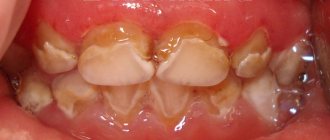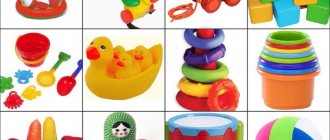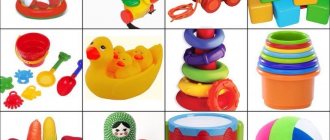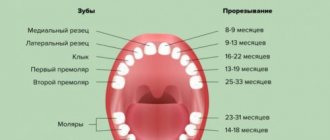26.11.2019
From about six months, the baby begins to be capricious, sleep becomes restless or may be completely absent. In most cases, you can easily diagnose the condition of the baby - teething. But it is precisely this physiological state of the baby that raises a large number of questions among parents. After all, this process is long and not always simple.
Harbingers of teething
Typically, teething begins by six months, about a couple of weeks before that, the “symptoms” of teething begin. All precursors of teething can be classified into two groups.
The first group includes general signs of teething, the second group includes local signs of teething.
Common signs of teething include frequent changes in the child’s mood, whims, poor and restless sleep of the baby, decreased appetite, and at some points the baby may simply refuse to eat for no apparent reason. Babies who are breastfed begin to latch on to the breast more often, one might say they simply “hang” on the chest.
In addition, babies constantly put everything in their mouths, everything that comes to hand. All objects that fall into the mouth are used by him to scratch his gums. Profuse salivation begins a little earlier than whims, but gradually, the amount of saliva released increases. But it is worth remembering that salivation is not always associated with teething. In most cases, the presence of abundant salivation indicates that the salivary glands are functioning properly.
Mothers of toddlers who are breastfed may complain of biting the breast during feeding; the number of feedings also increases, which is especially typical during the night period. Parents may also be concerned about a very specific type of runny nose, which is observed only when the front group of upper teeth, including fangs, erupt. Nasal discharge has a consistency similar to water and does not cause any inconvenience to the child. If green matter appears in the discharge, this indicates a secondary infection and you should consult a doctor.
The second group of signs of teething is local, which will more likely tell whether it is teething or not. When general signs of teething appear, the first thing you need to do is look into the baby’s mouth and carefully examine the gums. In the place where the first teeth should erupt, most often the lower front incisors, redness appears, and the gums may be slightly swollen.
All these symptoms indicate inflammation in the gums, which is a sure sign of teething. Immediately or after some time, you may notice a tooth through the gum that will soon erupt. Gradually, the tooth becomes more and more visible, and the first tooth can already be felt with your finger.
Signs of teething
Most often, the first teeth appear at the sixth to eighth month, but in some babies the incisor may emerge as early as four months or, conversely, teething will be delayed for six months. All this is quite normal for a healthy little organism.
Since the tooth literally needs to cut through soft tissue to appear, the first symptoms will be redness and slight swelling of the gums in this place. In addition, the following symptoms may indicate the rapid eruption of the first teeth:
- Increased amount of saliva.
Over the course of a few weeks, you may notice that drool is dripping and even leaking from your mouth - this is normal during the teething period. - Itchy gums.
The tooth that is preparing to appear irritates the gums, causing itching and unpleasant pain. The child, trying to reduce discomfort, more often puts toys and pacifiers, various other objects and his hands into his mouth. - Appetite and sleep disturbances.
Unrelenting itching prevents the child from falling asleep and prevents him from eating properly. - Heat.
Some children experience an increase in temperature during this period; be careful; if the fever does not subside for more than two days, consult a doctor. - Stool disorder.
Diarrhea often accompanies the appearance of the first teeth, but you should also be very careful with it. If it intensifies, is too intense, or lasts more than two days, or is accompanied by a change in the color and smell of the stool, be sure to tell your doctor. - Symptoms of ARVI.
Since a cutting tooth causes inflammation in the oral cavity, it is quite logical for a runny nose and cough to appear. The main thing is not to confuse these symptoms with a real disease.
How to speed up teething?
Often parents are excitedly waiting for teething, the child already has all the signs of teething, but the teeth themselves are still missing. So what to do? Everything is within normal limits, until the tooth erupts, it goes through a lot of obstacles. And the very first of them becomes bone tissue, the crown of a tooth, a path is paved. After the bone tissue, the tooth must also overcome the mucous membrane, which is more difficult, since this tissue is elastic.
In order to help teething, the child’s saliva contains special substances - salivary enzymes, which “melt” the mucous membrane and thereby contribute to the rupture of the mucous membrane and the appearance of a tooth. In addition, saliva also contains antibacterial agents that help cope with infection, which often appears during teething.
Parents should remember that teething cannot be accelerated in any way. Calcium supplements will not help. They are safely eliminated from the body, and only a small part is absorbed. The baby’s teeth do not erupt due to insufficient calcium; the teething process is much more complicated. Modern dentistry cannot yet accurately answer the question of what exactly causes teeth to erupt. The main theory is that the root of a baby tooth develops; it is its growth that causes the tooth to move. Of course, certain microelements are necessary for growth, but it also takes time for the cells to begin dividing.
Another serious mistake parents make is tearing gum tissue. Under no circumstances should you do this!!!
Firstly, it is worth remembering that it is very painful.
Secondly, it is worth remembering that there is a possibility of injury to the delicate tissues of a tooth that has not yet erupted, and an infection. The only exception is the corresponding operation during the eruption of wisdom teeth, when the so-called “hood” of the mucous membrane is removed in the surgical office.
To facilitate teething, the baby can be given “natural” teethers, for example, a piece of hard bread, crackers, bagels, and all hard foods that can “scratch” the gums. The generation of grandmothers will gladly give the little one a piece of refined sugar. What absolutely cannot be done, for many reasons.
Fever and other “symptoms”
A common complaint from parents is a significant increase in the child's temperature, loose stools, possibly vomiting and the presence of a rash. When contacting a pediatrician, some doctors blame everything on teething, without even trying to look for another reason.
Parents should know that teething cannot produce a high temperature above 38º that lasts more than three days. If the body temperature rises immediately above this figure, then consultation with a specialist is necessary.
Teething has nothing to do with loose stools, cramps, rashes, etc. When these symptoms appear, also with an increase in temperature, it is first necessary to suspect an intestinal infection and other diseases. And you need to urgently consult a doctor.
Many pediatricians and dentists claim that the reason for this condition of the child lies precisely in teething. But in order to refute this statement, it is enough just to understand the mechanism of eruption and the occurrence of temperature. The temperature rises in response to the formation of inflammation in the mucous membrane. But the area of inflammation is so small that the increase in temperature cannot be significant.
Symptoms such as loose stools and fever are more indicators of an intestinal infection; in addition, it is during this period that intestinal infections are most relevant, since the baby puts everything in his mouth.
Each child reacts differently to an increase in temperature, some children do not even notice the increase in temperature, their vital functions do not suffer in any way, the baby has a normal appetite. Another group of children tolerates elevated temperatures very hard; side effects often develop, for example, vomiting, diarrhea, cramps, etc. It turns out that diarrhea and vomiting may be independent manifestations of any disease, or associated with elevated temperature, but not as it is not related to teething.
How to help your child while teething?
Teething is a very difficult period for babies and parents. The baby is constantly tormented by itching, less often short-term pain, and other unpleasant symptoms. It is worth remembering that there are no 100% sure ways that will help alleviate the baby’s condition. Each baby is individual, and therefore it is necessary to approach this issue individually. Parents need to try different methods and observe the reaction.
Teething in a child most often begins at about six months of age; at this age, the introduction of complementary foods generally begins. Quite often, children refuse complementary feeding and demand their mother's breast. Thanks to this, babies receive not only the necessary nutrition, but also “painkillers”, “sedatives”, etc., which significantly alleviates the child’s condition. It is not recommended to insist on introducing complementary foods, otherwise you can simply provoke vomiting.
Dentists advise giving your child teethers, which can be different. The best characteristics are provided by teethers with fillings that must be pre-cooled. Cold can reduce itching and pain, and “scratching” the gums with a teether promotes faster teething.
You can massage the gums with a gauze pad previously soaked in cold water. Such actions simultaneously relieve itching in the toddler’s gums and clean the oral cavity. Before starting the procedure, parents' hands should be thoroughly washed. The massage should be neat, gentle, with the complete exclusion of pressing and sudden movements.
In order to reduce signs of inflammation, you can wipe your baby’s mouth with solutions of medicinal plants, such as chamomile decoction. You can use the decoction in various ways, give the kids to drink it, or gently wipe the mouth with it, make applications - applying for a while a gauze swab, generously soaked in the decoction.
In pharmacies and widely sold, there are many specialized gels for teething, which contain an anesthetic substance, in most cases it is lidocaine. Before using the gel, you must read the product label. The drug must be used according to strict instructions and in no case more often. Otherwise, it could end badly.
The mechanism of action of such drugs is based on superficial anesthesia (numbness) of the mucous membrane, due to which all unpleasant sensations are reduced and the baby can eat or fall asleep peacefully.
How to help your child with medicine when teething
For some children, homemade recipes and other non-drug methods do not help. This is due to the different sensitivity and susceptibility of the body of small patients. All medications should be selected exclusively by a doctor. It is likely that the infant has a history of chronic and other diseases for which drug therapy is strictly contraindicated. Self-prescription of pharmaceutical products can lead to allergic reactions and other side effects, so it is better not to rely on reviews on the Internet and advice from other mothers. Let's look at how to help a child teething with the help of medications.
Kalgel
The combined gel has an anesthetic and anti-inflammatory effect. The active ingredient is lidocaine, that is, inflamed and swollen gums seem to be “frozen.” Sold exclusively with a doctor's prescription. It is necessary to observe the exact dosage and avoid excessive use. The effect lasts for a long time.
Kamistad
Produced in Germany. The principle is almost identical to the previous drug, but the composition contains harmless polidocanol and tincture of chamomile flowers. Herbal components help eliminate pain, itching, inflammation, swelling and redness. The composition is sweet, so the little patient will not spit it out and will be happy to open his mouth. It is often prescribed by doctors for diseases of the oral cavity.
Holisal
The gel-like substance contains choline salicylate and auxiliary components. Prescribed also for adults. Allowed for use over six months of age. It acts quickly and relieves a wide range of dental problems. This is one of the best remedies for pain relief when a child is teething badly. The disadvantage is the higher cost compared to analogues.
Dentinox
A paste based on lidocaine and chamomile extract disinfects treated surfaces of the oral cavity, relieves pain and swelling of soft tissues. Unpleasant sensations are eliminated in a short period of time, the baby sleeps soundly, does not cry for no reason, and happily eats mother's milk or an adapted formula from a bottle. Since the gel is applied externally, it is completely safe when used in moderation.











